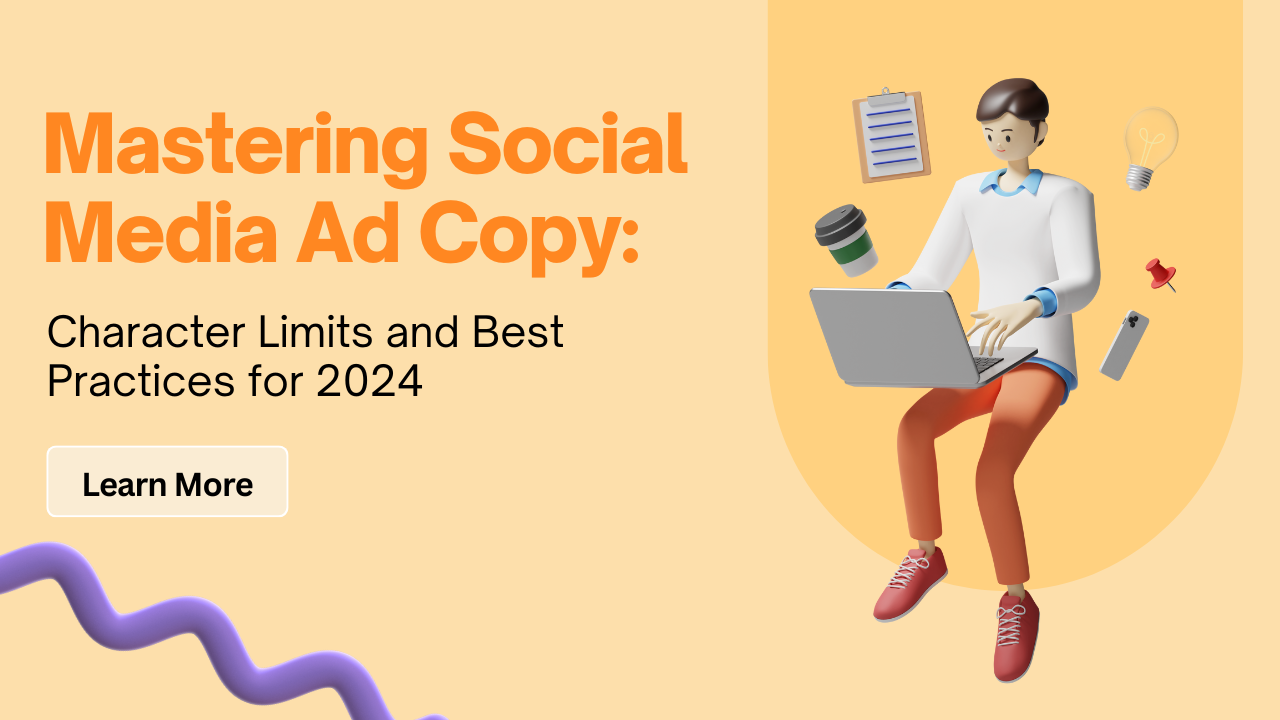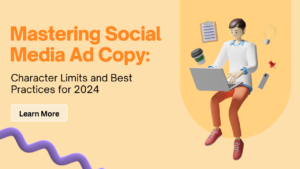Traditional Marketing vs. Digital Marketing: Which Strategy is Right for...
Read MoreMastering Social Media Ad Copy: Character Limits and Best Practices for 2024

Table of Contents
Introduction:
Understanding and navigating Google Ads character limits is a pivotal skill for digital marketers. These limits determine the amount of information you can include in your ad, making crafting concise and impactful messaging essential. Whether it’s text ads, responsive search ads, or display ads, adhering to these character constraints ensures your content is compliant and compelling. As digital advertising evolves in 2024, mastering these limits will be crucial for driving engagement and achieving your marketing goals.
Expanded Text Ads (ETAs)
Expanded Text Ads (ETAs) are a potent tool in Google Ads’ arsenal. They offer marketers a generous space to communicate their message while adhering to Google’s strict character limits. ETAs consist of three headline fields and two description lines, each serving a unique purpose in capturing user attention and driving clicks.
- Headlines 1, 2, and 3: Each headline can contain up to 30 characters. These headlines are the most visible part of your ad and the first thing users see. The key to crafting effective headlines is to make them compelling, concise, and relevant. Use this space to highlight your key value propositions, promotions, or calls to action. Since all three headlines can show simultaneously, ensure they work together to tell a cohesive story.
- Description Lines 1 and 2: Each description line offers up to 90 characters. These lines allow you to elaborate on your headlines, provide more details, or reinforce your call to action. This space is perfect for including additional benefits, unique selling points, or information that didn’t fit into the headlines.
- Path Fields: Besides the headline and description fields, ETAs include two optional path fields, each with a 15-character limit. These fields are part of the ad’s display URL and can reinforce the ad’s messaging by including relevant keywords or descriptors that indicate what users can expect on the landing page.
As mobile continues to dominate the search landscape, optimizing your ETAs for smaller screens is crucial. It means making your headlines and descriptions as clear and impactful as possible, even when viewed on a mobile device. Additionally, consider using A/B testing to experiment with different headline and description combinations to find the most effective messaging for your target audience. With Google’s continued emphasis on user experience, creating ETAs that comply with character limits and engage with users will be crucial for success in 2024.
Responsive Search Ads (RSAs)
Responsive Search Ads (RSAs) represent the next evolution in Google Ads, offering marketers the flexibility to create dynamic ads that adapt to user queries in real-time. Unlike traditional Expanded Text Ads (ETAs), RSAs allow you to input multiple headlines and descriptions, which Google’s algorithm then mixes and matches to find the best-performing combinations. This adaptive approach ensures your ads remain relevant across various search queries, making you more responsive to user needs.
- Headlines: With RSAs, you can input up to 15 different headlines, each with a 30-character limit. These headlines are the backbone of your ad and should be varied to cover various aspects of your product or service. Consider including a mix of brand-focused, benefit-driven, and call-to-action headlines to cater to different user intents. Google will automatically test different headline combinations to determine which ones perform best, so include a diverse range of messaging.
- Descriptions: RSAs allow for up to four descriptions, each with a 90-character limit. These descriptions provide context to your headlines and should expand on the key messages you want to convey. Like with headlines, it’s essential to vary your descriptions to see what resonates best with your audience. Use this space to highlight product details, special offers, or unique selling points that set you apart from competitors.
- Dynamic Ad Combinations: One of the most significant advantages of RSAs is their ability to generate ad combinations tailored to individual user searches dynamically. It means that, over time, your ads become more targeted and relevant, leading to higher click-through rates (CTR) and conversion rates. The more headline and description variations you provide, the more Google has to work with, increasing the likelihood of finding the perfect match for each query.
Best Practices for 2024:
To maximize the effectiveness of your RSAs, ensure that each headline and description can stand alone and still make sense. Since Google’s algorithm may show any combination of headlines and descriptions, they must be compelling independently and in any order. Additionally, regularly review your RSA performance and adjust your headlines and descriptions based on what’s working best. With RSAs playing an increasingly important role in Google Ads strategies for 2024, investing time in crafting diverse and impactful messaging will be vital in driving campaign success.
Display Ads
Display Ads are a visually driven component of Google Ads designed to engage users across Google’s extensive Display Network, which includes millions of websites, apps, and Google-owned properties like YouTube. Unlike search ads, which rely heavily on text, Display Ads combine images, text, and sometimes video to capture attention and drive conversions. In 2024, the potential of Display Ads is vast, inspiring digital marketers to leverage their creativity and understanding of visual and textual elements to create ads that stand out in a crowded digital landscape.
Critical Components of Display Ads
- Short Headlines: Display Ads feature a short headline with a 25-character limit. This headline is crucial for quickly grabbing attention, especially on mobile devices with limited screen space. Focus on being transparent, direct, and relevant. Whether promoting a product, offering a discount or building brand awareness, your short headline should immediately convey your key message.
- Long Headlines: When space allows, Google will display a long headline containing up to 90 characters. This gives you more room to elaborate on your message. The extended headline should build on the short headline, offering additional context or reinforcing the primary benefit. This is especially useful for delivering complex messages or enticing users with compelling offers.
- Descriptions: The description field in Display Ads is limited to 90 characters and should complement your headlines. Use this space to provide more details, such as product features, special promotions, or calls to action. The description should be persuasive and aligned with the visual elements of the ad, driving home the message you want to convey.
- Images and Visuals: While text is essential, visuals are the driving force behind Display Ads. High-quality, relevant images are necessary for catching the eye and drawing users into your ad. Whether using product images, lifestyle shots, or custom graphics, ensure they align with your brand identity and message. For 2024, consider using images that reflect current design trends, such as minimalism, bold typography, and vibrant colors, to make your ads more appealing.
- Call-to-Action (CTA): You must create a strong CTA to convert interest into action. Display your CTA prominently, whether it’s “Shop Now,” “Learn More,” or “Get Started,” to encourage users to take the next step. Pairing a clear CTA with compelling visuals and copy can significantly improve your click-through rates (CTR) and overall campaign effectiveness.
Best Practices for 2024
- Mobile Optimization: Since significant web traffic comes from mobile devices, you should optimize your Display Ads for smaller screens by using simple, bold visuals and concise, impactful text that is easy to read on mobile.
- A/B Testing: Continuously test different ad variations to find what resonates best with your audience. Experiment with headlines, descriptions, images, and CTAs to see what drives the highest engagement and conversion rates.
- Audience Targeting: Use Google’s advanced targeting options to show your Display Ads to the right people at the right time. Whether you’re targeting by demographics, interests, or behavior, precise targeting can help maximize the effectiveness of your Display Ads.
- Consistency with Branding: Ensure your Display Ads are consistent with your overall brand identity. This includes using brand colors, fonts, and messaging that align with your other marketing materials. Consistency helps build brand recognition and trust with your audience.
Smart Ads
Innovative Ads are integral to Google’s advertising suite, leveraging advanced machine learning to automate and optimize your ad campaigns. These ads are particularly effective for businesses that want to streamline their advertising efforts while achieving significant reach and impact. Brilliant Ads automatically adjust to fit various ad spaces across Google’s networks, ensuring your message is relevant and engaging to your target audience.
Critical Components of Smart Ads
- Headline: The headline in Smart Ads is limited to 25 characters, making it essential to be short, precise, and impactful. Given the character constraint, your headline should focus on delivering the core message or value proposition in the most direct way possible. Whether it’s a special offer, a key product benefit, or a compelling call to action, the headline needs to grab attention and communicate what you want users to know at a glance.
- Descriptions: The description field in Smart Ads allows for up to 70 characters. This space should highlight unique selling points or provide additional context to the headline. Since the description is also concise, every word counts. Focus on what makes your product or service stand out—a specific feature, a time-sensitive discount, or a critical benefit that resonates with your target audience. The description should complement the headline and encourage users to engage with your ad.
Advantages of Smart Ads
- Automation and Optimization: One of the most significant advantages of Smart Ads is their ability to optimize for performance automatically. Google’s algorithms continuously test different combinations of headlines, descriptions, and other elements to determine what works best for your audience. As the system adapts your ads to improve engagement and conversion rates, you can achieve better results with less manual effort.
- Broad Reach: Google designed Smart Ads to appear across its extensive network, including search results, display networks, YouTube, and more. This broad reach ensures that your ads are seen by a diverse audience, increasing the likelihood of attracting potential customers.
- Ease of Use: Smart Ads offers a straightforward solution for businesses with limited time or resources to manage ad campaigns. The setup process is simple; once the ads are live, they require minimal maintenance. Google’s AI handles the heavy lifting, allowing you to focus on other aspects of your business while still running effective ad campaigns.
Best Practices for 2024
- Focus on Clarity: Given the character limits, clarity is vital. Make sure your headlines and descriptions are easy to understand and directly communicate the value of your product or service. Avoid jargon or overly complex language.
- Leverage Unique Selling Points: Use the limited space in your descriptions to highlight what makes your offering unique. Whether it’s a feature that differentiates you from competitors or a special promotion, ensure it’s front and center.
- Monitor and Adjust: Although Smart Ads are primarily automated, it is essential to review performance data regularly. Use these insights to refine your headlines and descriptions, ensuring they resonate with your audience.
In 2024, Smart Ads will continue to be a valuable tool for businesses looking to simplify digital advertising while achieving impactful results. You can run successful campaigns that drive engagement and conversions with minimal effort by focusing on clear, concise messaging and allowing Google’s AI to optimize performance.
Key Considerations for 2024
As we move into 2024, staying ahead in digital advertising requires understanding Google Ads’ character limits and how to work within them.
Character count tools are essential for ensuring your headlines and descriptions remain within the prescribed limits and prevent any truncation that could weaken your message.
Adopting a mobile-first mindset is also crucial, as character limits can display differently on smaller screens. Therefore, your ads must be clear, concise, and impactful on mobile devices.
A/B testing has become more critical than ever; experimenting with different variations of headlines and descriptions will help you identify the most effective messaging that resonates with your target audience within the constraints. Focusing on these critical considerations optimizes your ad performance and drives better results throughout 2024.
Conclusion
Adhering to Google Ads character limits while crafting impactful messages is crucial for successful advertising in 2024. By staying within these constraints and focusing on clarity, relevance, and engagement, you can ensure that your ads meet Google’s guidelines and resonate effectively with your audience. Regularly reviewing and optimizing your ad content based on performance data will help refine your messaging and enhance overall campaign effectiveness. Embracing these best practices will enable you to maximize your ad performance and achieve better results in the competitive digital landscape.
The Marketo Advantage: Streamline, Automate, and Grow Your Business
The Marketo Advantage: Streamline, Automate, and Grow Your Business Table...
Read MoreMastering Social Media Ad Copy: Character Limits and Best Practices for 2024
Mastering Social Media Ad Copy: Character Limits and Best Practices...
Read MoreWhy Analytics Matter in Performance Marketing: Leveraging Data to Achieve Success
Why Analytics Matter in Performance Marketing: Leveraging Data to Achieve...
Read More





